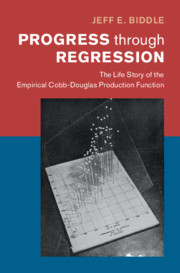Book contents
- Progress through Regression
- Historical Perspectives On Modern Economics
- Progress through Regression
- Copyright page
- Dedication
- Contents
- Figures
- Acknowledgments
- Introduction
- Part I Paul Douglas and His Regression, 1927–1948
- Part II The Diffusion of the Cobb–Douglas Regression
- 4 Three Important Developments in the Life of the Cobb–Douglas Regression, 1952–1961
- 5 The Cobb–Douglas Regression in Agricultural Economics, 1944–1965
- 6 The Cobb–Douglas Regression as a Tool for Measuring and Explaining Economic Growth
- Part III Conclusion
- References
- Index
- Historical Perspectives On Modern Economics
4 - Three Important Developments in the Life of the Cobb–Douglas Regression, 1952–1961
from Part II - The Diffusion of the Cobb–Douglas Regression
Published online by Cambridge University Press: 30 October 2020
- Progress through Regression
- Historical Perspectives On Modern Economics
- Progress through Regression
- Copyright page
- Dedication
- Contents
- Figures
- Acknowledgments
- Introduction
- Part I Paul Douglas and His Regression, 1927–1948
- Part II The Diffusion of the Cobb–Douglas Regression
- 4 Three Important Developments in the Life of the Cobb–Douglas Regression, 1952–1961
- 5 The Cobb–Douglas Regression in Agricultural Economics, 1944–1965
- 6 The Cobb–Douglas Regression as a Tool for Measuring and Explaining Economic Growth
- Part III Conclusion
- References
- Index
- Historical Perspectives On Modern Economics
Summary
This chapter provides background for later chapters’ case studies of the diffusion of the Cobb–Douglas regression after WWII, reviewing three developments that affected economists’ perception and use of the regression in the 1950s and 1960s: (i) The presentation of the Cobb–Douglas regression in the first “Econometrics” textbooks, which gave a positive impression of the importance and potential of empirical production function research. (ii) E. H. Phelps Brown’s 1957 article criticizing the Cobb–Douglas regression technique. Phelps Brown identified serious problems with Douglas’s methods and claims, but his criticisms often did not apply to, or were effectively answered by, newer research using the regression, and so did little to slow the diffusion of the technique. (iii) The introduction of the CES production function by Arrow, Chenery, Minhas, and Solow in 1961. The CES production function was the first generalization of Cobb–Douglas to be widely adopted by empirical researchers. Also, the authors used assumptions about competition, optimization, and equilibrium to estimate thier production function parameters, a new strategy approach that became a widely accepted practice.
Keywords
- Type
- Chapter
- Information
- Progress through RegressionThe Life Story of the Empirical Cobb-Douglas Production Function, pp. 145 - 168Publisher: Cambridge University PressPrint publication year: 2020

